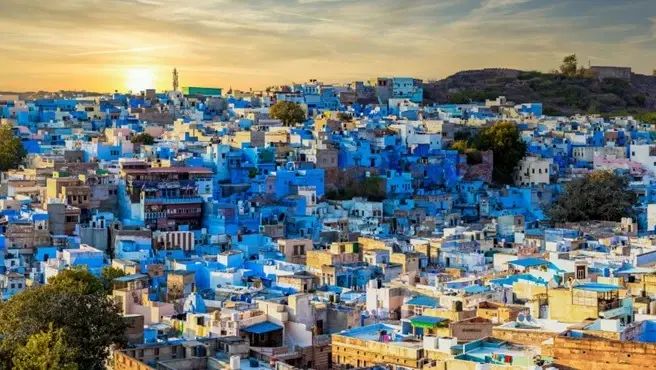
Flights
•04 min read

Imagine strolling through a maze of vibrant, indigo-painted lanes, where every turn tells a story defined by history and culture. The blue houses of Jodhpur are not just a visual delight but a living canvas that captures the spirit of this enchanting city. This blog will guide you through the origins, cultural significance, and architectural charm of these iconic blue houses, while offering practical tips for exploring one of Rajasthan's most mesmerizing destinations.
Jodhpur has earned its nickname, the "Blue City," due to its widespread tradition of painting homes in shades of blue. Historically, the Brahmin community started this practice, linking the color to spirituality and tradition. Beyond cultural symbolism, the blue pigment serves a practical purpose by keeping the interiors cool in the desert heat and deterring insects. This fusion of aesthetics and functionality forms the essence of Jodhpur's enduring charm.
The practice of painting houses blue has roots deep in Jodhpur’s history, particularly in areas like Brahmpuri. Influenced by Rao Jodha, the founder of Jodhpur, the city’s architectural evolution embraced a distinct style where traditional constructs met practicality and climate-responsive design. Over time, the blue houses have become a defining visual element, narrating a history that spans generations.
The best places to witness the blue magic are in the old city areas such as Brahmpuri, Navchokiya, and Pachetia Hill. Each area offers a unique view of the city's indigo allure. Iconic viewpoints like Mehrangarh Fort provide panoramic vistas of the blue cityscape, connecting visitors not only with the visual splendor but also with the city's rich heritage.
Walking through the narrow, winding lanes of Jodhpur’s old city is an experience that entices all the senses. As you meander through hidden courtyards and bustling local markets, you can almost touch history. The charming traditional homes, with their painted walls and intricate designs, invite you to pause and absorb the essence of Rajasthan.
The indigo pigment used to paint Jodhpur’s houses is not just an aesthetic choice—it helps maintain a cooler indoor temperature in the intense heat and is believed to ward off termites and other pests.

The architectural style of the blue houses showcases an intriguing blend of Rajput and Mughal influences. Intricate carvings, lattice windows, and flat rooftops provide both functionality and a distinctive visual appeal. The blue houses of Jodhpur stand as monuments of heritage, symbolizing the city’s evolution and cultural pride.
Mehrangarh Fort looms large over the blue houses, offering not just a breathtaking view, but also a historical context. The fort’s imposing structure has influenced the urban planning of the old city. Its strategic placement and enduring legacy provide a backdrop that enriches the story of Jodhpur’s legacy and architectural grandeur.
For the best experience, visit Jodhpur in the cooler months when the temperatures are milder. The city comes alive with festivals such as the Marwar Festival, where cultural performances, handicraft fairs, and local cuisines add vibrancy to the blue surroundings. Each season offers a nuanced view of the blue city, allowing visitors to experience it in different lights.
Exploring Jodhpur requires a blend of practicality and openness to adventure. Hiring local guides can offer valuable insights into hidden gems, while comfortable footwear is a must for navigating the narrow, cobbled lanes. Respect local customs and traditions to fully immerse yourself in the city's historic ambiance. Nearby attractions like the Clock Tower, Jaswant Thada, and Rao Jodha Desert Rock Park are also worth a visit.
Finding a place to stay that offers a view of the blue marvels is key to experiencing Jodhpur fully. Accommodations range from charming heritage stays to comfortable homestays located within the old city's labyrinth. Such lodgings allow you to wake up to panoramic views of the vivid blue canvas that defines this magical place.
While the blue houses captivate visitors, Jodhpur is home to numerous other attractions. Iconic landmarks like Umaid Bhawan Palace and Mandore Gardens, along with the bustling local markets, offer contrasting yet complementary experiences to the serene blue backdrop. These attractions collectively paint a broader picture of the city's rich heritage and evolving modernity.

As modernization touches every corner of the globe, preserving the blue houses of Jodhpur poses distinct challenges. Environmental changes and rapid urban development are factors that threaten this delicate balance. Embracing sustainable tourism becomes essential to ensure that future generations can continue to enjoy the vibrant legacy of these painted blue houses. In the spirit of effortless travel and exploration, [] plays a role in encouraging mindful tourism that respects local traditions and the environment.
The houses are painted blue due to a blend of cultural, spiritual, and practical reasons, including traditions of the Brahmin caste, cooling effects, and pest deterrence.
The best spots include the old city areas of Brahmpuri, Navchokiya, and Pachetia Hill, with Mehrangarh Fort offering panoramic views of the blue cityscape.
It is often called so because the indigo shade of the houses creates a serene, almost heavenly visual against the desert backdrop.
Historically, the Brahmin community began the tradition, which later spread among the residents, solidifying Jodhpur’s distinctive blue identity.
Yes, large parts of the old city feature painted blue houses, lending Jodhpur its famous nickname.
The blue houses of Jodhpur are a brilliant testament to a city where history, artistry, and practical wisdom converge. These indigo-painted homes not only narrate tales of a rich cultural past but also continue to enchant modern travelers with their timeless beauty. As you explore this blue city, you discover a fusion of heritage and innovation that defines the vibrant spirit of Rajasthan.